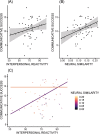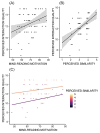Partner similarity and social cognitive traits predict social interaction success among strangers
- PMID: 37698369
- PMCID: PMC10516339
- DOI: 10.1093/scan/nsad045
Partner similarity and social cognitive traits predict social interaction success among strangers
Abstract
Social interactions are a ubiquitous part of engaging in the world around us, and determining what makes an interaction successful is necessary for social well-being. This study examined the separate contributions of individual social cognitive ability and partner similarity to social interaction success among strangers, measured by a cooperative communication task and self-reported interaction quality. Sixty participants engaged in a 1-h virtual social interaction with an unfamiliar partner (a laboratory confederate) including a 30-min cooperative 'mind-reading' game and then completed several individual tasks and surveys. They then underwent a separate functional MRI session in which they passively viewed video clips that varied in content. The neural responses to these videos were correlated with those of their confederate interaction partners to yield a measure of pairwise neural similarity. We found that trait empathy (assessed by the interpersonal reactivity index) and neural similarity to partner both predicted communication success in the mind-reading game. In contrast, perceived similarity to partner and (to a much lesser extent) trait mind-reading motivation predicted self-reported interaction quality. These results highlight the importance of sharing perspectives in successful communication as well as differences between neurobiological similarity and perceived similarity in supporting different types of interaction success.
Keywords: empathy; neural similarity; perceived similarity; social interaction; social skills.
© The Author(s) 2023. Published by Oxford University Press.
Conflict of interest statement
The authors declared that they had no conflict of interest with respect to their authorship or the publication of this article.
Figures





References
-
- Baumeister R.F., Leary M.R. (1995). The need to belong: desire for interpersonal attachments as a fundamental human motivation. Psychological Bulletin, 117(3), 497–529. - PubMed
-
- Behrmann M., Geng J.J., Shomstein S. (2004). Parietal cortex and attention. Current Opinion in Neurobiology, 14(2), 212–7. - PubMed
-
- Bernieri F.J., Rosenthal R. (1991). Interpersonal coordination: behavior matching and interactional synchrony. In: Feldman, R.S., Rime, B., editors. Fundamentals of Nonverbal Behavior. Cambridge, UK: Cambridge University Press, 401–32.

